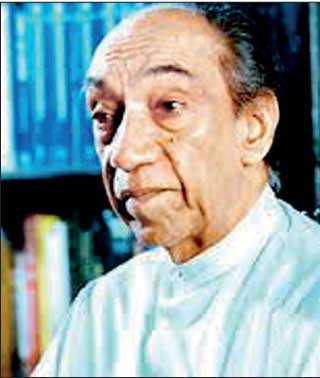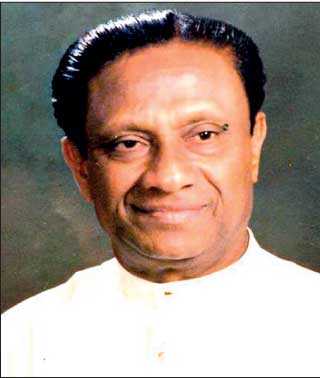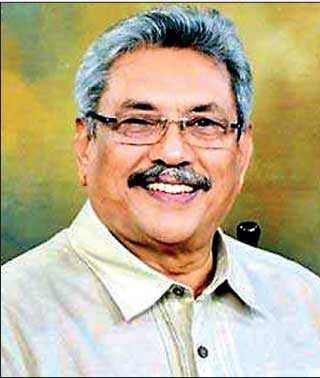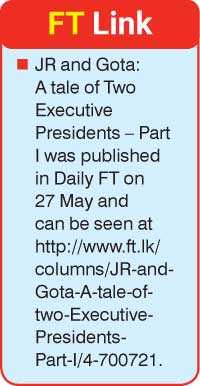Sunday Dec 14, 2025
Sunday Dec 14, 2025
Wednesday, 10 June 2020 00:20 - - {{hitsCtrl.values.hits}}
 |
| President J.R. Jayewardene |
 |
| President Ranasinghe Premadasa |
 |
| President Gotabaya Rajapaksa
|
Junius Richard Jayewardene’s reign as Executive President which began in 1978 came to an end in 1988. Even at the tail-end of his tenure, the grandmaster of political chess did toy with the idea of contesting for a third term by amending the Constitution again. Fortunately, for all concerned, such an eventuality did not occur.
JR was dissuaded from taking the extreme step of contesting a third time. He was 82 and his wife Elena was determined that JR should retire from politics. JR too was so inclined. By July 1988, it became known among close confidantes that JR was not going to contest again. But in a tactical move to keep the SLFP guessing and presidential aspirants in the UNP quiet, JR kept the question of his contesting again wide open for a long time.
JR announced formally in September 1988 that he was retiring from politics. This announcement was followed by a UNP meeting comprising the Parliamentary Group and Working Committee. Everyone expected JR to have an inner-party election to finalise the candidate. But JR did not want an intra-party contest at that juncture. So he sprung a surprise by proposing the name of Ranasinghe Premadasa as the presidential candidate and would-be successor.
In a further twist, JR got Lalith Athulathmudali and Gamini Dissanayake, Premadasa’s chief competitors, to jointly second Premadasa’s nomination. Ranasinghe Premadasa was unanimously elected as the presidential candidate of the UNP.
Nominations closed on 10 November 1988. The Presidential Election was held on 19 December 1988. In a tight contest, Ranasinghe Premadasa of the UNP came first with 2,569,199 (50.43%) votes. Sirimavo Bandaranaike of the SLFP came second with 2,289,860 (44.95%) votes. Oswin (Ossie) Abeygunasekara of the SLMP came a poor third with 235,719 (4.63%) votes. Ranasinghe Premadasa was elected as the second Executive President of Sri Lanka. In the February 1989 Elections, the UNP obtained 125 seats in a Parliament of 225 MPs.
Premadasa’s hegemonic leadership
As stated in the first part of this article, JR functioned like a virtual Constitutional dictator by exercising full executive presidential powers as well as retaining a strangle hold on a “captive” Parliament where his party had an enormous majority. JR was like a Gulliver among his Lilliputian UNP colleagues.
In Ranasinghe Premadasa’s case he did not tower above his Parliamentary colleagues like his predecessor. Premadasa had been accepted – grudgingly by some – as a “Primus Inter Pares” or ‘First Among Equals’. Besides the UNP won only 125 MPs out of 225 in 1989 as opposed to the party getting 141 seats in a Parliament of 168 MPs in 1977.
Premadasa however seemed oblivious to the difference between JR and himself as Presidents. He tried to follow in the footsteps of JR as an authoritarian president. It was well-known that Premadasa was a slave driver in getting bureaucrats and officials to work. Now he displayed the same tendency towards his Parliamentary colleagues too.
Even though Gamini Dissanayake and Lalith Athulathmudali had not challenged him at the Presidential Poll, Premadasa was most unforgiving. He elevated D.B. Wijetunga as Prime Minister and Finance Minister while relegating Dissanayake and Athulathmudali to less important ministries. Later Dissanayake was deprived of a cabinet portfolio by Premadasa. When Dissanayake requested six months’ leave to pursue further studies at Cambridge University, Premadasa agreed and then dropped Gamini from cabinet in a re-shuffle.
Furthermore Premadasa began cracking the whip against his ministers and MPs too. Severe restrictions were imposed on them. The unkindest cut of all was the setting up of a special investigation unit under retired DIG of Police A.C. Lawrence. Allegations of bribery, corruption, abuse and misuse of power by ministers, MPs, provincial councillors and senior officials were delegated to this unit for further probing by the President himself. This unit dubbed “Gestapo” was resented and feared by many of Premadasa’s ministers and MPs. Most Ministers and MPs apart from a favoured few found themselves powerless in practice under the hegemonic leadership of Ranasinghe Premadasa.
Revolt against Premadasa
In such a situation, a revolt against Premadasa was inevitable. The trio comprising Gamini Dissanayake, Lalith Athulathmudali and G.M. Premachandra were the architects of a conspiracy to impeach President Premadasa. Initially Speaker M.H. Mohammed was also suspected of being aligned with these clandestine moves.
Signatures were canvassed from several Opposition party MPs and “dissident” MPs from the UNP itself. According to some reports around 140 signatures had been collected but not the required number of two-thirds or 150.
Premadasa came to know of the impeachment move and nipped it in the bud with the support of ministers like Ranil Wickremesinghe, Sirisena Cooray and Weerasinghe Mallimarachchi. Most of the UNP signatories were coaxed, cajoled and coerced into backing out. Some denied that they had ever been involved. Finally the Speaker announced that he was not entertaining the impeachment motion.
After safeguarding himself and consolidating his position, Premadasa came down hard on the UNP ring leaders of the impeachment move and the few other party MPs who openly admitted to signing the motion. Ten UNP Parliamentarians including Dissanayake, Athulathmudali and Premachandra were expelled from the party and consequently forfeited their seats.
Although Premadasa triumphed in the impeachment crisis, the experience impacted strongly on him. No longer could the President take his UNP Parliamentarians for granted. A future revolt could very well materialise if the President rubbed the Parliamentarians the wrong way. Thus President Premadasa was compelled to reduce his arrogant attitude and dictatorial conduct. He was forced to relax the stringent conditions imposed on his ministers and MPs.
Provisions to restrain powerful executive presidency
Although the executive presidency was created as an institution independent of Parliament, JR’s inclination of always working through Parliament and not having a non-Parliamentary Executive had given the Legislature greater power even in an executive presidential system. The prevailing political reality in JR’s time was that the UNP Leader was also in absolute control of the Legislature. Practical politics decreed that an executive president required full Parliamentary strength to be all-powerful.
 |
 |
When the powerful executive presidency was introduced in Sri Lanka, political scientists pointed out three provisions by which Parliament could check or restrain the president. The first was the passing of an impeachment motion with a two-thirds majority. The second was voting against the allocation of funds to the president. The third was the restriction on a President to dissolve a newly-elected Parliament for a one year period. This period has now been extended to four-and-a-half years by the 19th Constitutional Amendment.
It was this four-and-a-half year mandatory period which prevented Maithripala Sirisena from dissolving Parliament and having elections in 2018. This is also why President Gotabaya Rajapaksa had to wait until March this year to dissolve Parliament.
The impeachment experience of Premadasa demonstrated that a Parliament capable of mustering a hostile majority against the incumbent president could be the Achilles’ heel of the powerful executive presidency. Subsequent elections where the ruling party or coalition could not garner an adequate majority resulted in individuals, groups and minor parties in the Opposition being enticed into Government folds by way of “incentives” Thereafter it was necessary to retain such a stable majority through positions, perks and privileges.
The undesirable practice of creating an unnecessarily large number of ministries and appointing totally unsuitable MPs as ministers, state ministers and deputy ministers became a way of life. Former Presidents Chandrika Kumaratunga, Mahinda Rajapaksa and Maithripala Sirisena were all “guilty” of this deplorable practice.
It could be seen therefore that the powerful executive presidency which progressed smoothly under J.R. Jayewardene received a nasty jolt during the time of Ranasinghe Premadasa. All elected presidents worked mainly through Parliaments. They were all comfortable in working with and working through Parliament. From J.R. Jayewardene to Maithripala Sirisena all the executive presidents had served in Parliament (in Chandrika’s case a few months only) before assuming office as President.
The solitary exception to this rule is current President Nandasena Gotabaya Rajapaksa. As is well known, President Gotabaya Rajapaksa hails from a well-known political family whose members spanning three generations have been Parliamentarians. However Gota contested and won the Presidential Election without ever having been a Member of Parliament.
Another difference between Gotabaya and his predecessors like Chandrika, Mahinda and Maithripala is that he never pledged to abolish the executive presidency during his election campaign.
The executive presidency goes on and on
The executive presidency has been in existence for more than 40 years now. The presidential system has come in for much criticism from the time of its inception. The blame for almost everything that has gone wrong in Sri Lanka has been laid at the door of JR’s executive presidency.
It became the politically-correct fashion of the day to condemn the executive presidency as the root of all evil in the island. From the time of the revolt led by Gamini Dissanayake and Lalith Athulathmudali against former President Ranasinghe Premadasa in 1991, Sri Lankan political discourse was permeated with strident demands for the abolition of the executive presidency.
The first Sinhala “talkie” film to be made was released in 1947. The title of the film was ‘Kadawunu Poronduwa’ meaning ‘Broken Promise’. What the Sri Lankan people have been seeing for nearly 25 years has been a long line of broken promises as far as the promise to abolish the executive presidency was concerned.
What the country has been witnessing is the spectacle of presidential candidates pledging to abolish the executive presidency during elections and not fulfilling their promises after being elected. Only President Sirisena and Prime Minister Wickremesinghe tried to reduce presidential powers to some extent by way of the 19th Constitutional Amendment. Despite demands for its extinction, the executive presidency has been enjoying a longevity in political terms.
Various governments have come and gone. Different presidents have come and gone. But the executive presidency goes on and on. The chief reason for this has been the inability or unwillingness of political parties in general and the two main parties in particular to arrive at a consensus on abolishing the executive presidency.
The executive presidency can be abolished or downsized only through a constitutional amendment or a new constitution. This requires a two-thirds majority in Parliament and endorsement by the people at a referendum. The regimes commanding a two-thirds majority in Parliament did not want to do away with the presidency. The regimes wanting to eliminate the executive presidency did not have a two-thirds majority. Where there was power there was no will. Where there was will there was no power. Hence a consensus of key political parties on abolishing the executive presidency has remained as elusive as ever.
President Gotabaya Rajapaksa’s stance
It is against this backdrop that Gotabaya Rajapaksa was elected President last year. The new President articulated his policy viewpoints on Parliament and the Presidency in his Parliamentary address of 3 January. This is what he said about Parliament:
“I remember my father being at this Parliament, during my childhood. I often used to watch Parliamentary proceedings from the public gallery. The Parliament we had then was exemplary. The discourse that took place in it was of great importance. The debates were replete with logic and rich arguments. School children and adults were eager to come to Parliament to listen to those debates. Members of Parliament always behaved in a way that upheld the dignity of the Parliament and the office they held. The people then had great respect for the Parliament. They respected people’s representatives. Unfortunately, latterly, that respect gradually waned.
“This Parliament should once again become an exemplary institution where the real issues of the people are discussed, where matters concerned with national policy are subjected to debate, and where the responsibilities of the legislature are duly fulfilled. The responsibility of ensuring that the Parliament once again becomes an institution winning the respect of the people lies with the Members who are in this House.”
Speaking further President Rajapaksa outlined the need for strengthening the executive presidency through constitutional reform. This is what he said:
“The success of a democracy rests upon the Constitution. The 1978 Constitution, which has since been amended on 19 occasions, has given rise to many problems at the present time because of its inherent ambiguities and confusions. In order to safeguard the security, sovereignty, stability and integrity of our country, it is essential that changes be made to the existing Constitution.
“Whilst preserving the positive characteristics of the proportional representation system, electoral reforms are needed to ensure the stability of the Parliament and to ensure the direct representation of the people. Even though elections can be won through numbers, an unstable Parliament that cannot take clear decisions and remains constantly under the influence of extremism is not one that suits the country. We can solve this problem through constitutional reforms that will establish a strong Executive, Legislature and an independent Judiciary that can ensure the sovereignty of the people.”
The above paragraphs excerpted from the President’s maiden Parliamentary address indicate that Gotabaya Rajapaksa’s vision of constitutional reform envisages the establishment of a strong Executive, stable Legislature and an independent Judiciary.
The 19th Constitutional Amendment
The 19th Constitutional Amendment has curtailed some of the executive president’s powers and strengthened Parliament and the office of the prime minister. This led to some legal pundits and political analysts to opine that the executive presidency has been stripped of many powers and that the president to be elected in November 2019 would be a titular head only.
Others disagreed. For instance Dr. Asanga Welikala in an article written for the Daily FT in October last year observed thus: “It will be seen that while the 19th Amendment made certain fundamental changes to the structure of government under the 1978 Constitution, it did not abolish the semi-presidential model of government underpinning that Constitution. …formalistic legal arguments based on the constitutional text alone to the effect that the presidency becomes a merely ceremonial institution after the next presidential election are wide of the mark.”
President Gotabaya Rajapaksa has been in office for more than six months now. As stated in the first part of this article, “What we have today is a powerful president with a dissolved Parliament who steers the ship of state with the aid of a ‘caretaker’ Cabinet and a Prime Minister who did not command a majority in the last Parliament. Although the country faces a health emergency in the form of the COVID-19 pandemic it has no functioning Parliament. Due to exceptional circumstances, Gotabaya Rajapaksa is arguably Sri Lanka’s first ‘standalone Executive President not dependent on the Legislature’ today.” These and other related issues concerning Gotabaya Rajapaksa’s executive presidency will be examined in greater detail in the third and final part of this article.
(D.B.S. Jeyaraj can be reached at [email protected])
